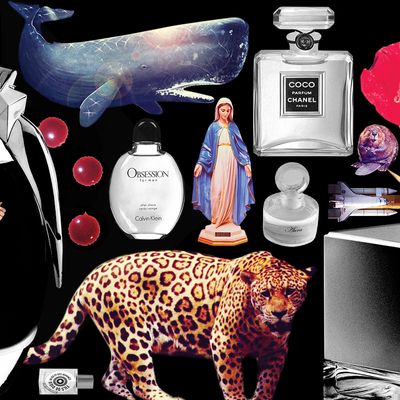
When Lady Gaga recently relieved herself in a trash can on the set of Watch What Happens Live, Andy Cohen did the obvious: He bottled it and made a perfume. (“U HAVE BEEN WARNED IF HE TRIES TO SPRITZ U,” she tweeted.) Gross, yes, but in the more-primal-the-better world of perfumery, bodily fluids are in good company. Here, some of the stranger ingredients in your fragrances.
Rose Petals From Space
Zen by Shiseido
In 1998, NASA let the industry giant International Flavors & Fragrances put a rose on the space shuttle Discovery to see if zero gravity affected its essential oils, and, in turn, its smell. The resulting scent—“floral, woody, and spiritual”—was incorporated into a perfume and sold, predictably, in a sleek, sci-fi-esque bottle.
Civet Musk
Obsession for Men by Calvin Klein
Its musky, vanilla-like scent, meant to capture “the determination and fire that drives men’s passions,” is also a turn-on for Guatemalan jaguars. Field researchers trying to film the big cats in the wild used it to draw them toward heat- and motion-sensitive cameras. Bronx Zoo researchers made the initial discovery; there, Obsession for Men enthralled cats eleven minutes longer than Estée Lauder’s Beautiful.
Blood and Semen
Lady Gaga Fame
Initial reports said that, to smell like an “expensive hooker,” Lady Gaga’s 2012 unisex scent would contain blood and semen. Neither made the cut. Even molecular equivalents were deemed too “disgusting” by the perfumer. Instead, the post-coital scent was achieved using belladonna, saffron, and incense.
Virgins
Virgin No. 1 by Thierry Mugler
In Patrick Süskind’s 1985 novel Perfume, a tortured-genius perfumer murders virgins for their scent. In real life, a fragrance lab captured it without bloodshed using polymer needles. Produced as part of a limited quantity set, the scent is now a collector’s item.
Ambergris
Chanel No. 5 (allegedly)
This waxy lump from the digestive tract of sperm whales is a coveted preservative and fragrance enhancer. It was possibly an ingredient in the original Chanel No. 5. These days, it has largely been replaced by alternatives, but rumor has it the real thing still turns up in overseas perfumes.
Castoreum and Hyraceum
Fils de Dieu du riz et des argumes by Etat Libre d’Orange
Castoreum, from the anal secretions of beavers, is prized for its pleasant vanilla aroma. Many fragrance-makers now use a synthetic replacement or turn to hyraceum, from the hyrax, whose viscous urine, once compacted and fossilized, hardens into a rocklike material with a sensual, earthy scent.
*This article originally appeared in the December 9, 2013 issue of New York Magazine.

